History of Armenia
| History of Armenia | |
|---|---|
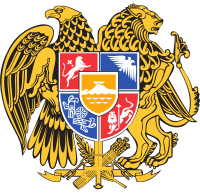 This article is part of a series |
|
| Ancient Armenia | |
| Name of Armenia | |
| Hayk | |
| Hayasa-Azzi | |
| Nairi | |
| Urartu | |
| Antiquity | |
| Orontid Armenia | |
| Kingdom of Armenia | |
| Kingdom of Sophene | |
| Kingdom of Commagene | |
| Lesser Armenia | |
| Artaxiad Dynasty | |
| Roman Armenia | |
| Arsacid Dynasty | |
| Medieval history | |
| Marzpanate Period | |
| Byzantine Armenia | |
| Arab conquest of Armenia | |
| Emirate of Armenia | |
| Bagratuni Armenia | |
| Kingdom of Vaspurakan | |
| Armenian Kingdom of Cilicia | |
| Zakarid Armenia | |
| Foreign rule | |
| Persian · Ottoman · Russian | |
| Armenian national movement | |
| Hamidian massacres | |
| Armenian Genocide | |
| Contemporary Armenia | |
| Democratic Republic of Armenia | |
| Armenian Soviet Socialist Republic | |
| Republic of Armenia | |
|
Armenia Portal |
- See History of Armenia (Movses Khorenatsi) for the historiographical work.

Armenia lies in the highlands surrounding the Biblical mountains of Ararat. The original Armenian name for the country was Hayk, later Hayastan (Armenian: Հայաստան), translated as the land of Haik, and consisting of the name Haik and the suffix '-stan' (land).
The name Armenia was given to the country by the surrounding states, and it is traditionally derived from Armenak or Aram (the great-grandson of Haik's great-grandson, and another leader who is, according to Armenian tradition, the ancestor of all Armenians). In the Bronze Age, several states flourished in the area of Greater Armenia, including the Hittite Empire (at the height of its power), Mitanni (South-Western historical Armenia), and Hayasa-Azzi (1600-1200 BC). Soon after the Hayasa-Azzi were the Nairi (1400-1000 BC) and the Kingdom of Urartu (1000-600 BC), who successively established their sovereignty over the Armenian Highlands. Each of the aforementioned nations and tribes participated in the ethnogenesis of the Armenian people.[1] Yerevan, the modern capital of Armenia, was founded in 782 BC by king Argishti I.
The Iron Age kingdom of Urartu (Assyrian for Ararat) was replaced by the Orontid dynasty. Following Persian and Macedonian rule, the Artaxiad dynasty from 190 BC gave rise to the Kingdom of Armenia which rose to the peak of its influence under Tigranes II before falling under Roman rule.
In 301, Arsacid Armenia was the first sovereign nation to accept Christianity as a state religion. The Armenians later fell under Byzantine, Persian, and Islamic hegemony, but reinstated their independence with the Bagratuni Dynasty kingdom of Armenia. After the fall of the kingdom in 1045, and the subsequent Seljuk conquest of Armenia in 1064, the Armenians established a kingdom in Cilicia, where they prolonged their sovereignty to 1375.
Greater Armenia was later divided between the Ottoman Empire and Russia. Armenians then suffered in the genocide that was inflicted on them by the Ottomans. As a result, 1.5 million Armenians were murdered and a large number were dispersed throughout the world via Syria and Lebanon. Armenia, from then on corresponding to much of Eastern Armenia, once again gained independence in 1918, with the establishment of the Democratic Republic of Armenia, and then in 1991, with the Republic of Armenia.
Contents |
Prehistory
The Armenian Highland shows traces of settlement from the Neolithic era.
The Shulaveri-Shomu culture of the central Transcaucasus region is one of the earliest known prehistoric culture in the area, carbon-dated to roughly 6000 - 4000 BC.
Bronze Age
An early Bronze Age culture in the area is the Kura-Araxes culture, assigned to the period of ca. 4000 - 2200 BC, succeeded by the Trialeti culture (ca. 2200 - 1500 BC). The earliest ethnonyms of the area are known from Hittite sources of the Late Bronze Age, such as the Hayasa-Azzi or the Mushki.
Between 1500 - 1200 BC, the Hayasa-Azzi existed in the western half of the Armenian Highland, often clashing with the Hittite Empire. Between 1200 - 800 BC, much of Armenia was united under a confederation of kingdoms, which Assyrian sources called Nairi ("Land of Rivers" in Assyrian").
Iron Age
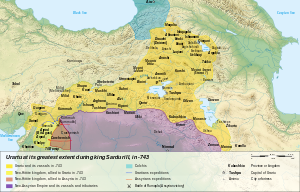
The Kingdom of Urartu flourished in the Caucasus and eastern Asia Minor between the 9th century BC[2] and 585 BC[3] in the Armenian Highland. The founder of the Urartian Kingdom, Aramé, united all the principalities of the Armenian Highland and gave himself the title "King of Kings", the traditional title of Urartian Kings.[4] The Urartians established their sovereignty over all of Taron and Vaspurakan. The main rival of Urartu was the Neo-Assyrian Empire.[5]
During the reign of Sarduri I (834-828 BC), Urartu had become a strong and organized state, and imposed taxes to neighbouring tribes. Sarduri made Tushpa (modern Van) the capital of Urartu. His son, Ishpuinis, extended the borders of the state by conquering what would later be known as the Tigranocerta area and by reaching Urmia. Menuas (810-785 BC) extended the Urartian territory up north, by spreading towards the Araratian fields. He left more than 90 inscriptions by using the Mesopotamian cuneiform scriptures in the Urartian language. Argishtis I of Urartu conquered Latakia from the Hittites, and reached Byblos, Phoenicia, and he built Erebuni,modern-day Yerevan, in 782 BC by using 6600 prisoners of war. In 714 BC, the Assyrians under Sargon II defeated the Urartian King Rusa I at Lake Urmia and destroyed the holy Urartian temple at Musasir. At the same time, an Indo-European tribe called the Cimmerians attacked Urartu from the northwest region and destroyed the rest of his armies.
The Medes under Cyaxares invaded Assyria later on in 612 BC, and then took over the Urartian capital of Van towards 585 BC, effectively ending the sovereignty of Urartu.[6] According to the Armenian tradition, the Medes helped the Armenians establish the Orontid dynasty.
Antiquity
- For more details on this topic, see Roman relations with the Armenians.
After the fall of Urartu around 585 BC, the Kingdom of Armenia was ruled by the Armenian Orontid Dynasty, which governed the state in 585 - 190 BC. Under Orontids, Armenia at times was an independent kingdom, and at other times a satrapy of the Persian Empire. Darius III was an Armenian satrap before he became the emperor of Persia.
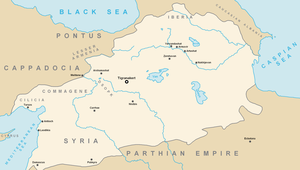
Artaxiad dynasty
After the destruction of the Seleucid Empire, a Hellenistic Armenian state was founded in 190 BC.

It was a Hellenistic Greek successor state of Alexander the Great's short-lived empire, with Artaxias becoming its first kings and the founder of the Artaxiad dynasty (190 BC - AD 1).
At the same time, a western portion of the kingdom split as a separate state under Zariadris, which became known as Lesser Armenia while the main kingdom acquired the name of Greater Armenia.[3]
The new kings began a program of expansion which was to reach its zenith a century later. Their acquisitions are summarized by Strabo. Zariadris acquired Acilisene and the "country around the Antitaurus", possibly the district of Muzur or west of the Euphrates.
Artaxias took lands from the Medes, Iberians, and Syrians. He then had confrontations with Pontus, Seleucid Syria and Cappadocia, and was included in the treaty which followed the victory of a group of Anatolian kings over Pharnaces of Pontus in 181 BC. Pharnaces thus abandoned all of his gains in the west.[7]
At its zenith, from 95 to 66 BC, Greater Armenia extended its rule over parts of the Caucasus and the area that is now eastern and central Turkey, northwestern Iran, Israel, Syria and Lebanon, forming the second Armenian empire. For a time, Armenia was one of the most powerful states in the Roman East.
It eventually confronted the Roman Republic in a war, which it lost in 66 BC, but nonetheless preserved its sovereignty. Tigranes continued to rule Armenia as an ally of Rome until his death in 55 BCE.[8]
Indeed the third Mithridatic war defeat of the King of Pontus by Roman Pompeius resulted in the Kingdom of Armenia becoming an allied client state of Rome.
Later on, in 1 AD, Armenia came under full Roman control until the establishment of the Armenian Arsacid dynasty. The Armenian people then adopted a Western political, philosophical, and religious orientation. According to Strabo, around this time everyone in Armenia spoke "the same language." (Strabo 11.14.4).
Roman Province of Armenia
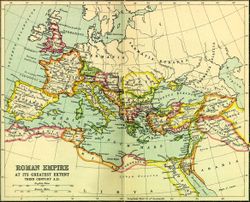
From Pompeius' campaign Armenia was, in part or whole, subject to the Roman Empire for nearly four centuries. Roman emperor Trajan created even a short-lived Province of Armenia between 114 and 117 AD.[9]
Indeed Roman supremacy was fully established by the campaigns of Gnaeus Domitius Corbulo.[10], that ended with a formal compromise: a Parthian prince of the Arsacid line would henceforth sit on the Armenian throne, but his nomination had to be approved by the Roman emperor.
Because this agreement was nor respected by the Parthian Empire, in 114 Trajan from Antiochia in Syria marched on Armenia and conquered the capital Artaxata. Trajan then deposed the Armenian king Partamasiri (imposed by the Parthians) and ordered the annexation of Armenia to the Roman Empire as a new province.
The new province reached the shores of the Caspian sea and bordered to the north with Caucasian Iberia and Caucasian Albania, two vassal states of Rome. As a Roman province Armenia was administered by Catilius Severus of the Gens Claudia.
After Trajan's death however, his successor Hadrian decided not to maintain the province of Armenia. In 118 AD, Hadrian gave Armenia up, and installed Parthamaspates as its "vassal" king.
Arsacid dynasty
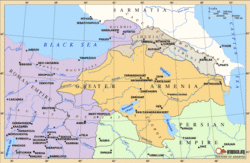
Armenia was often a focus of contention between Rome and Parthia.[11] The Parthians forced Armenia into submission from 37 to 47, when the Romans retook control of the kingdom.
Under Nero, the Romans fought a campaign (55–63) against the Parthian Empire, which had invaded the kingdom of Armenia, allied to the Romans. After gaining (60) and losing (62) Armenia, the Romans under Gnaeus Domitius Corbulo, legate of Syria entered (63) into an agreement of Vologases I of Parthia, which confirmed Tiridates I as king of Armenia, thus founding the Arshakuni Dynasty.
The Arsacid dynasty lost control of Armenia for a few years when emperor Trajan created the "Roman Province of Armenia", fully included into the Roman Empire from 114 to 117 AD. His successor Hadrian reinstalled the Arsacid Dynasty when nominated Parthamaspates as "vassal" king of Armenia in 118 AD.
Another campaign was led by Emperor Lucius Verus in 162-165, after Vologases IV of Parthia had invaded Armenia and installed his chief general on its throne. To counter the Parthian threat, Verus set out for the east. His army won significant victories and retook the capital. Sohaemus, a Roman citizen of Armenian heritage, was installed as the new client king.[12]
The Sassanid Persians occupied Armenia in 252 and held it until the Romans returned in 287. In 384 the kingdom was split between the Byzantine or East Roman Empire and the Persians.[13] Western Armenia quickly became a province of the Roman Empire under the name of Armenia Minor; Eastern Armenia remained a kingdom within Persia until 428, when the local nobility overthrew the king, and the Sassanids installed a governor in his place.
According to tradition, the Armenian Apostolic Church was established by two of Jesus' twelve apostles--Thaddaeus and Bartholomew--who preached Christianity in Armenia in the 40's-60's AD.[14] Between 1st and 4th centuries AD, the Armenian Church was headed by patriarchs.
Christianized Arsacid dynasty
In 301, Armenia became the first nation to adopt Christianity as a state religion.[15] It established a church that still exists independently of both the Catholic and the Eastern Orthodox churches, having become so in 451 after having rejected the Council of Chalcedon.[16] The Armenian Apostolic Church is a part of the Oriental Orthodox communion, not to be confused with the Eastern Orthodox communion. The first Catholicos of the Armenian church was Saint Gregory the Illuminator.[17] Because of his beliefs, he was persecuted by the pagan king of Armenia, and was "punished" by being thrown in Khor Virap, in modern-day Armenia.[18] He acquired the title of Illuminator, because he illuminated the spirits of Armenians by introducing Christianity to them.
During its later political eclipses, Armenia depended on the church to preserve and protect its unique identity.
In 405/406, Armenia's political future seemed to be uncertain. With the help of the King of Armenia, Mesrop Mashtots thus invented a unique alphabet to suit the people's needs.[19] By doing so, he ushered a new Golden Age and strengthened the Armenian national identity and belongingness.
After years of partial rule, the Arsacid dynasty fell in 428, with Eastern Armenia being subjugated to Persia and Western Armenia, to Rome. In the 5th century, the Sassanid Shah Yazdegerd II tried to tie his Christian Armenian subjects more closely to the Sassanid Empire by imposing the Zoroastrian religion.[20] The Armenians greatly resented this, and as a result, a rebellion broke out with Vartan Mamikonian as the leader of the rebels. Yazdegerd thus massed his army and sent it to Armenia, where the Battle of Avarayr took place in 451. The 66,000 Armenian rebels,[21] mostly peasants, lost their morale when Mamikonian himself died in the battlefield. They were substantially outnumbered by the 180,00-220,000-strong[22] Persian army of Immortals and war elephants. Despite being a military defeat, the Battle of Avarayr and the subsequent guerrilla war in Armenia eventually resulted in the Treaty of Nvarsak (484), which guaranteed religious freedom to the Armenians.[23]
Middle Ages
Byzantium and Bagratid Armenia
In 591, the Byzantine Emperor Maurice defeated the Persians and recovered much of the remaining territory of Armenia into the empire. The conquest was completed by the Emperor Heraclius in 629.
In 645, the Muslim Arab armies of the Caliphate had attacked and conquered the country. Armenia, which once had its own rulers and was at other times under Persian and Byzantine control, passed largely into the power of the Caliphs.
Nonetheless, there were still parts of Armenia held within the Empire, containing many Armenians. This population held tremendous power within the empire. The Emperor Heraclius (610-641) was of Armenian descent, as was the Emperor Philippicus (711-713). The Emperor Basil I, who took the Byzantine throne in 867, was the first of what is sometimes called the Armenian dynasty (see Macedonian Dynasty), reflecting the strong effect the Armenians had on the Eastern Roman State.[24] The Armenians were able and allowed to maintain a distinct culture.
Evolving as a feudal kingdom in the 9th century, the Bagratuni Dynasty led Armenia on a brief cultural, political, and economic renewal. Bagratid Armenia was eventually recognized as a sovereign kingdom by the two major powers in the region: Baghdad in 885, and Constantinople in 886. Ani, the new Armenian capital, was constructed at the Kingdom's apogee in 964.[25] The royal capital at Ani held approximately 200,000 inhabitants and a reported "1001 churches". With the construction of Ani, Armenia became a populous and prosperous nation, exerting political and economic influence over surrounding states and nations. Yet, Armenia was still a weak state, perched precariously between the rival Byzantine Empire and the Abbassid Caliphate. Its existence depended on both of these states desiring the continuation of Bagratid Armenia as a buffer state, and Armenia itself being strong enough to maintain this status.

Although the native dynasty of the Bagratuni Dynasty was founded under favourable circumstances, the feudal system gradually weakened the country by eroding loyalty to the central government. Thus internally enfeebled, Armenia proved an easy victim for the Byzantines, who captured Ani in 1045. The Seljuk Turks under Alp Arslan in turn took the city in 1064.[26] In 1071, after the defeat of the Byzantine forces by the Seljuk Turks at the Battle of Manzikert, the Turks captured the rest of Greater Armenia and much of Anatolia.[27] So ended Christian leadership of Armenia for the next millennium with the exception of a period of the late 12th-early 13th centuries, when the Muslim power in Greater Armenia was seriously troubled by the resurgent Georgian monarchy. Many local nobles (nakharars) joined their efforts with the Georgians, leading to liberation of several areas in northern Armenia, which was ruled, under the authority of the Georgian crown, by the Zacharids/Mkhargrdzeli, a prominent Armeno-Georgian noble family.[28]
Armenian Kingdom of Cilicia
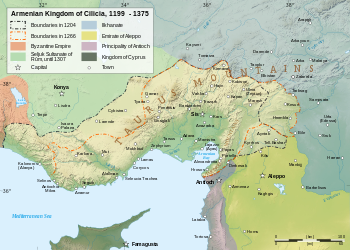
To escape death or servitude at the hands of those who had assassinated his relative, Gagik II, King of Ani, an Armenian named Roupen with some of his countrymen went into the gorges of the Taurus Mountains and then into Tarsus of Cilicia. Here the Byzantine governor of the place gave them shelter. Thus, from around 1080 to 1375, the focus of Armenian nationalism moved south, as the Armenian Kingdom of Cilicia.
After the members of the first Crusade appeared in Asia Minor, the Armenians developed close ties to European Crusader States, flourished in southeastern Asia Minor until it was conquered by Muslim states. Count Baldwin, who with the rest of the Crusaders was passing through Asia Minor bound for Jerusalem, left the Crusader army and was adopted by Thoros of Edessa, an Armenian ruler of Greek Orthodox faith.[29] Hostile as they were to the Seljuks, and unfriendly to the Byzantines, the Armenians took kindly to the crusader count, and when Thoros was assassinated, Baldwin was made ruler of the new crusader County of Edessa. It seems that the Armenians enjoyed the rule of Baldwin and the crusaders in general, and some number of them fought alongside the Christians of Europe. When Antioch had been taken (1097), Constantine, the son of Roupen, received from the crusaders the title of baron.
The failed Third Crusade and other events elsewhere left Cilicia as the sole substantial Christian presence in the Middle East.[29] World powers, such as Byzantium, the Holy Roman Empire, the Papacy and even the Abbassid Caliph competed and vied for influence over the state and each raced to be the first to recognise Leo II, prince of Lesser Armenia, as the rightful king. As a result, he had been given a crown by both German and Byzantine emperors. Representatives from across Christendom and a number of Muslim states attended the coronation, thus highlighting the important stature that Cilicia had gained over time.[29] The Armenian authority was often in touch with the crusaders. No doubt the Armenians aided in some of the other crusades. Cilicia flourished greatly under Armenian rule, as it became the last remnant of Medieval Armenian statehood. Cilcia acquired an Armenian identity, as the kings of Cilicia were called kings of Armenians, not of Cilicians. In Lesser Armenia, Armenian culture was intertwined with both the European culture of the Crusaders, and with the Hellenic culture of Cilicia. As the Catholic families extended their influence over Cilicia, the Pope wanted the Armenians to follow Catholicism. This situation divided the kingdom's inhabitants between pro-Catholic and pro-Apostolic camps. Armenian sovereignty lasted till 1375, when the Mamelukes of Egypt profited from the unstable situation of Lesser Armenia and destroyed it.
Early Modern period
Persian Armenia

Due to its strategic significance, Armenia was constantly fought over and passed back and forth between the dominion of Persia and the Ottomans. At the height of the Turkish-Persian wars, Yerevan changed hands fourteen times between 1513 and 1737.
In 1604, Shah Abbas I pursued a scorched-earth campaign against the Ottomans in the Ararat valley. The old Armenian town of Julfa in the province of Nakhichevan was taken early in the invasion. From there Abbas' army fanned out across the Araratian plain. The Shah pursued a careful strategy, advancing and retreating as the occasion demanded, determined not to risk his enterprise in a direct confrontation with stronger enemy forces.
While laying siege to Kars, he learned of the approach of a large Ottoman army, commanded by Djghazadé Sinan Pasha. The order to withdraw was given; but to deny the enemy the potential to resupply themselves from the land, he ordered the wholesale destruction of the Armenian towns and farms on the plain. As part of this the whole population was ordered to accompany the Persian army in its withdrawal. Some 300,0000 people were duly herded to the banks of the Araxes River. Those who attempted to resist the mass deportation were killed outright. The Shah had previously ordered the destruction of the only bridge, so people were forced into the waters, where a great many drowned, carried away by the currents, before reaching the opposite bank. This was only the beginning of their ordeal. One eye-witness, Father de Guyan, describes the predicament of the refugees thus:
-
- It was not only the winter cold that was causing torture and death to the deportees. The greatest suffering came from hunger. The provisions which the deportees had brought with them were soon consumed... The children were crying for food or milk, none of which existed, because the women's breasts had dried up from hunger... Many women, hungry and exhausted, would leave their famished children on the roadside, and continue their tortuous journey. Some would go to nearby forests in search of something to eat. Usually they would not come back. Often those who died, served as food for the living.
Unable to maintain his army on the desolate plain, Sinan Pasha was forced to winter in Van. Armies sent in pursuit of the Shah in 1605 were defeated, and by 1606 Abbas had regained all of the territory lost to the Turks earlier in his reign. The scorched-earth tactic had worked, though at a terrible cost to the Armenian people. Of the 300,000 deported it is calculated that under half survived the march to Isfahan. In the conquered territories Abbas established the Erivan khanate, a Muslim principality under the dominion of the Safavid Empire. Armenians formed less than 20% of its population[30] as a result of Shah Abbas I's deportation of much of the Armenian population from the Ararat valley and the surrounding region in 1605.[31]
An often-used policy by the Persians was the oppointment of Turks and Kurds as local rulers. These were counted as subordinate to the Persian Empire, but most of them had a de facto independence. Examples include: the Khanate of Erevan, Khanate of Nakhichevan and the Karabakh Khanate.
Russian Armenia

In the aftermath of the Russo-Persian War, 1826-1828, the parts of historic Armenia under Persian control, centering on Yerevan and Lake Sevan, were incorporated into Russia. Under Russian rule, the area corresponding approximately to modern-day Armenian territory was called "Province of Yerevan". The Armenian subjects of the Russian Empire lived in relative safety, compared to their Ottoman kin, albeit clashes with Tatars and Kurds were frequent in the early 20th century.
During the 19th and early 20th centuries, the ambitious Russians sought out to continue their expansion into Armenian land in order to reach the warm waters of the Mediterranean. This caused conflict between the Russian and Ottoman Empires eventually culminating in the Russo-Turkish War, 1828-1829. In the aftermath of the war, the Ottoman Empire ceded a small part of the traditional Armenian homeland to the Russian Empire, known as Eastern Armenia following the while Western Armenia remained under Ottoman sovereignty.
Ottoman Armenia
-Armenian_patriarch.png)
Mehmed II conquered Constantinople from the Byzantines in 1453, and made it the Ottoman Empire's capital. Mehmed and his successors used the religious systems of their subject nationalities as a method of population control, and so Ottoman Sultans invited an Armenian archbishop to establish an Armenian patriarchate in Constantinople. The Armenians of Constantinople grew in numbers, and became respected, if not full, members of Ottoman society.
The Ottoman Empire ruled in accordance to Islamic law. As such, the People of the Book (the Christians and the Jews) had to pay an extra tax to fulfill their status as dhimmi and in return were guaranteed religious autonomy. While the Armenians of Constantinople benefitted from the Sultan's support and grew to be a prospering community, the same could not be said about the ones inhabiting historic Armenia. During times of crisis the ones in the remote regions of mountainous eastern Anatolia were mistreated by local Kurdish chiefs and feudal lords. They often also had to suffer (alongside the settled Muslim population) raids by nomadic Kurdish tribes.[32] Armenians, like the other Ottoman Christians (though not to the same extent), had to transfer some of their healthy male children to the Sultan's government due to the devşirme policies in place. The boys were then forced to convert to Islam (by threat of death otherwise) and educated to be fierce warriors in times of war, as well as Beys, Pashas and even Grand Viziers in times of peace.
The Armenian national liberation movement was the Armenian effort to free the historic Armenian homeland of eastern Anatolia and Transcaucasus from Russian and Ottoman domination and re-establish the independent Armenian state. The national liberation movement of the Balkan peoples and the immediate involvement of the European powers in the Eastern question had a powerful effect on the development of the national liberation ideology movement among the Armenians of the Ottoman Empire.[33] The Armenian national movement, besides its individual heroes, was an organized activity represented around three parties of Armenian people, Social Democrat Hunchakian Party, Armenakan and Armenian Revolutionary Federation, which ARF was the largest and most influential among the three. Those Armenians who did not support national liberation aspirations or who were neutral were called chezoks.
In 1839, the situation of the Ottoman Armenians slightly improved after Abdul Mejid I carried out Tanzimat reforms in its territories. However, later Sultans, such as Abdul Hamid II stopped the reforms and carried out massacres, now known as the Hamidian massacres of 1895-96 after a failed Armenian attempt to assassinate him.
Twentieth century
The Armenian Genocide (1915-1917)

In 1915, the Ottoman Empire systematically carried out the Armenian Genocide. This genocide was preceded by a wave of massacres in the years 1894 to 1896, and another one in 1909 in Adana. In 1915, with World War I in progress, the Ottoman Turks accused the (Christian) Armenians as liable to ally with Russia, and treated the entire Armenian population as an enemy within their empire in a wave of ethnic cleansing.
The events of 1915 to 1923 are regarded by Armenians and the vast majority of Western historians to have been state-sponsored mass killings. Turkish authorities, however, maintain that the deaths were the result of a civil war coupled with disease and famine, with casualties incurred by both sides.
The exact numbers of deaths is hard to establish. It is estimated by many sources that close to a million and a half Armenians perished in camps, which excludes Armenians who may have died in other ways. Most estimates place the total number of deaths between 600,000 (by Western scholars)[34]. These events are traditionally commemorated yearly on April 24, the Armenian Christian martyr day.
This horrific ethnic cleansing done by the İttihat ve Terakki were not only done to Armenians, ethnic cleansing regimes were also carried on to the Greeks and Assyrians.[35] This act of ethnic cleansing was done by the Ottoman Turks to "turkify" the Ottoman Empire completely. These acts of genocide were done not only from 1915 till 1918, but before and after as well.
Democratic Republic of Armenia (1917-1922)
Between the 4th and 19th centuries, the traditional area of Armenia was conquered and ruled by Persians, Byzantines, Arabs, Mongols, and Turks, among others. Historic Armenia remained under the Ottoman yoke from, until parts of Armenia gained independence from the Ottoman Empire and the Russian Empire after the collapse of these two empires in the wake of the First World War.
After the Russian Revolution of 1917 and the takeover of the Bolsheviks, Stepan Shaumyan was placed in charge of Russian Armenia. In September 1917 the convention in Tiflis elected the Armenian National Council, the first sovereign political body of Armenians since the collapse of Lesser Armenia in 1375. Meanwhile, both the Ittihad (Unionist) and the Nationalists moved to win the friendship of the Bolsheviks. Mustafa Kemal sent several delegations to Moscow in an attempt to win some support for his own post-Ottoman movement in what he saw as a modernised ethno-nationalist Turkey. This alliance proved disastrous for the Armenians. The signing of the Ottoman-Russian friendship treaty (January 1, 1918), helped Vehib Pasha to attack the new Republic. Under heavy pressure from the combined forces of the Ottoman army and the Kurdish irregulars, the Republic was forced to withdraw from Erzincan to Erzurum. In the end, the Republic had to evacuate Erzurum as well.
Further southeast, in Van, the Armenians resisted the Turkish army until April 1918, but eventually were forced to evacuate it and withdraw to Persia. Conditions deteriorated when Azerbaijani Tatars sided with the Turks and seized the Armenian's lines of communication, thus cutting off the Armenian National Councils in Baku and Erevan from the National Council in Tiflis.
The Democratic Republic of Armenia (DRA) was established in Erevan on May 28, 1918.
In 1920, Armenian border troops skirmished with Muslim warlords in the former Georgian region of Oltu, on the border with the DRA. Turkish General Kazım Karabekir then led four Turkish battalions into the district on 3 September and drove the Armenians out. Karabekir then moved into the DRA on 20 September prompting the Armenian government to declare war on Turkey four days later, thus precipitating the Turkish-Armenian War.
The consequences of the DRA's war with Turkey were severe. In the Treaty of Alexandropol, the young Armenian republic was to disarm most of its military forces, cede more than 50% of its pre-war territory, and to give up all the territories granted to it at the Treaty of Sèvres. However, as the terms of defeat were being negotiated, Bolshevik Grigoriy Ordzhonikidze invaded the DRA from Azerbaijan in order to establish a new pro-Bolshevik government in the country. On November 29, the Soviet 11th Army invaded Armenia at Karavansarai (present-day Ijevan) and by November 29, 1920, the Soviet 11th Army marched into Yerevan.
Although the Bolsheviks succeeded in ousting the Turks from their positions in Armenia, they decided to establish peace with Turkey. In 1921, the Bolsheviks and the Turks signed the Treaty of Kars, in which Turkey ceded Adjara to the USSR in exchange for the Kars territory (today the Turkish provinces of Kars, Iğdır, and Ardahan). The land given to Turkey included the ancient city of Ani and Mount Ararat, the spiritual Armenian homeland. In 1922, Armenia became part of the Soviet Union as one of three republics comprising the Transcaucasian SFSR.
Armenia in the Soviet Union (1922-1991)
The Transcaucasian SFSR was dissolved in 1936 and as a result Armenia became a constituent republic of the Soviet Union as the Armenian Soviet Socialist Republic. The transition to communism was difficult for Armenia, and for most of the other republics in the Soviet Union. The Soviet authorities placed Armenians under strict surveillance. There was almost no freedom of speech, even less so under Joseph Stalin. Any individual who was suspected of using or introducing nationalist rhetoric or elements in their works were labeled traitors or propangandists, and were sent to Siberia during Stalinist rule. Even Zabel Yessayan, a writer who was fortunate enough to escape from ethnic cleansing during the Armenian Genocide, was quickly exiled to Siberia after repatriating to Armenia from France.
Soviet Armenia participated in World War II by sending hundreds of thousands of soldiers to the frontline in order to defend the "Soviet motherland." Soviet rule also had some positive aspects. Armenia benefited from the Soviet economy, especially when it was at its apex. Provincial villages gradually became towns and towns gradually became cities. Peace between Armenia and Azerbaijan was reached, albeit temporarily. During this time, Armenia had a sizeable Azeri minority, mostly centred in Yerevan. Likewise, Azerbaijan had an Armenian minority, concentrated in Baku, Kirovabad, and Nagorno-Karabakh. This demographic would change dramatically during and after the Nagorno-Karabakh war.
Many Armenians still had nationalist sentiments, even though they were discouraged from expressing them publicly. On April 24, 1965, tens of thousands of Armenians flooded the streets of Yerevan to remind the world of the horrors that their parents and grandparents endured during the Armenian Genocide of 1915. This was the first public demonstration of such high numbers in the USSR, which defended national interests rather than collective ones. In the late 1980s, Armenia was suffering from pollution. With Mikhail Gorbachev's introduction of glasnost and perestroika, public demonstrations became more common. Thousands of Armenians demonstrated in Yerevan because of the USSR's inability to address simple ecological concerns. Later on, with the conflict in Karabakh, the demonstrations obtained a more nationalistic flavour. Many Armenians began to demand statehood.
Independent Armenia (1991-today)
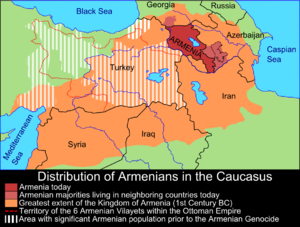
Armenia declared its sovereignty from the Soviet Union on August 23, 1990. In the wake of the August Coup, a referendum was held on the question of secession. Following an overwhelming vote in favor, full independence was declared on September 21, 1991. However, widespread recognition did not occur until the formal dissolution of the Soviet Union on December 25, 1991.
Armenia faced many challenges during its first years as a sovereign state. In 1988, the Spitak Earthquake killed tens of thousands of people and destroyed multiple towns in northern Armenia, such as Leninakan (modern-day Gyumri) and Spitak. Many families were left without electricity and running water. The harsh situation caused by the earthquake and subsequent events made many residents of Armenia leave and settle in North America, Western Europe or Australia.
On February 20, 1988, interethnic fighting between the ethnic Armenians of Nagorno-Karabakh and Azerbaijanis broke out shortly after the parliament of Nagorno-Karabakh, an autonomous oblast in Azerbaijan, voted to unify the region with Armenia. The Nagorno-Karabakh war pitted Armenians of Nagorno-Karabakh, backed by Armenia, against the Army of Azerbaijan. Following the Armenian victory, both Azerbaijan and Turkey closed their borders and imposed a blockade which they retain to this day, though in October 2009 Turkey and Armenia signed a treaty to normalize relations. These events severely affected the economy of the fledgling republic, and closed off its main routes to Europe.
On October 16, 1991, Armenians elected Levon Ter-Petrossian as their first president. Ter-Petrossian was faced with many difficulties, including economic difficulties caused mainly by the Turkish and Azeri blockade. His controversial banning of the Armenian Revolutionary Federation, one of the main organized political entities in the Armenian diaspora, and his apathy toward the pursuit of international recognition of the Armenian Genocide and the Nagorno-Karabakh Republic made him unpopular with Armenian citizens and diasporan Armenians during his final years as president of Armenia. He was forced to resign in February 1998.
After Robert Kocharyan came to power in 1998, the difficult life conditions of Armenia gradually started to change. The Armenian diaspora, and especially the ARF, obtained more freedom to carry out economic projects in the fatherland.
In 2006, the Republic of Armenia celebrated its 15th anniversary of independence.
Legendary history
The legendary founder of Armenia was Haik, a chieftain who called on his kinsmen to unite into a single nation, thus forming Armenia. Ararat was the mountain around which was centered Urartu and subsequent kingdoms, and is still considered sacred by the Armenians.
The original Armenian name for the country was Hayq, later Hayastan, translated as the land of Haik, and consisting of the name Haik and the Iranian suffix '-stan' (land). According to legend, Haik was a great-great-grandson of Noah (son of Togarmah, who was a son of Gomer, a son of Noah's son, Yafet), and according to tradition, a forefather of all Armenians. Mount Ararat, a sacred mountain for the Armenian people, rising in the center of the Armenian Highland as its highest peak, is traditionally considered the landing place of Noah's Ark.
See also
- Timeline of Armenian history
- Timeline of Armenian national movement
- History of Nagorno-Karabakh
- Armenian Rebellions
- Zakarid Armenia
- List of Armenian Patriarchs
- List of Armenian Kings
- List of Patriarchs of Armenia
References
- ↑ Vahan Kurkjian, "History of Armenia", Michigan, 1968, [1]; Armenian Soviet Encyclopedia, v. 12, Yerevan 1987; Artak Movsisyan, "Sacred Highland: Armenia in the spiritual conception of the Near East", Yerevan, 2000; Martiros Kavoukjian, "The Genesis of Armenian People", Montreal, 1982
- ↑ "Ancient Near East Chronology". http://www.gis.net/~pldr/anech.html. Retrieved 2007-02-06.
- ↑ 3.0 3.1 "Urartu/Armenia". http://www.livius.org/arl-arz/armenia/armenia.html. Retrieved 2007-02-06.
- ↑ "Transanatolie - Kings of Urartu". http://www.transanatolie.com/English/Turkey/Anatolia/urartu.htm. Retrieved 2007-02-06.
- ↑ "ArcImaging (Archeological Imaging Research Consortum)". http://arcimaging.org/. Retrieved 2007-02-06.
- ↑ (Armenian) Kurdoghlian, Mihran (1994). Badmoutioun Hayots, Volume I. Hradaragoutioun Azkayin Oussoumnagan Khorhourti. pp. 46–48.
- ↑ Redgate, Elizabeth (1998). The Armenians. Blackwell Publishing. pp. 65–68.
- ↑ Fuller, J.F.C. (1991). Julius Caesar: Man, Soldier, and Tyrant. Da Capo Press. pp. 45. ISBN 0306804220.
- ↑ Google Book: Cassio Dione and the Trajan "Province of Armenia" (in Italian)
- ↑ Vahan Kurkjian: Armenia and the Romans
- ↑ "The Parthian Period". http://www.angelfire.com/nt/Gilgamesh/parthian.html. Retrieved 2007-02-06.
- ↑ HA Marcus Antoninus 9.1, Verus 7.1; Dio Cass. 71.3.
- ↑ "Armenia: History". http://www.cac-biodiversity.org/arm/arm_history.htm. Retrieved 2007-02-06.
- ↑ "Church of Armenia". http://philtar.ucsm.ac.uk/encyclopedia/christ/early/armen.html. Retrieved 2007-02-06.
- ↑ "Information about Armenia on nationalgeographic.com". http://www3.nationalgeographic.com/places/countries/country_armenia.html. Retrieved 2007-02-06.
- ↑ "Armenian Church History and Doctrine". http://www.geocities.com/Athens/Thebes/1089/christology.html. Retrieved 2007-02-06.
- ↑ "The Holy City and the Mother Church of St. Etchmiadzin". http://www.hyeetch.nareg.com.au/religion/h_see_p1.html. Retrieved 2007-02-06.
- ↑ "Khor Virap Travel Guide". http://www.world66.com/europe/armenia/khorvirap. Retrieved 2007-02-06.
- ↑ "Armenian alphabet, pronunciation and language". http://www.omniglot.com/writing/armenian.htm. Retrieved 2007-02-06.
- ↑ "The Sassanids, to 500 CE". http://www.fsmitha.com/h1/ch22c.htm. Retrieved 2007-02-06.
- ↑ "Timeline - Armenia". http://timelinesdb.com/listevents.php?subjid=12&title=Armenia. Retrieved 2007-02-06.
- ↑ "Avarayr". http://www.iranica.com/newsite/articles/v3f1/v3f1a040.html. Retrieved 2007-02-06.
- ↑ "ARMENIANS (September 8, 1987)". http://www.umd.umich.edu/dept/armenian/papazian/armenia.html. Retrieved 2007-02-06.
- ↑ "Basil I in Encyclopaedia Britannica". http://concise.britannica.com/ebc/article-9013608/Basil-I. Retrieved 2007-02-06.
- ↑ "Armenia Sacra". http://www.louvre.fr/media/repository/ressources/sources/pdf/src_document_52304_v2_m56577569831159973.pdf. Retrieved 2007-02-08.
- ↑ "Alp Arslan". http://historymedren.about.com/od/aentries/a/11_alparslan.htm. Retrieved 2007-02-06.
- ↑ "Byzantium and Its Influence on Neighboring Peoples". http://www.metmuseum.org/explore/Byzantium/byz_6.html. Retrieved 2007-02-08.
- ↑ http://rbedrosian.com/appa.htm
- ↑ 29.0 29.1 29.2 "Cilicia: A Historical Overview". http://www.accc.org.uk/News/CILICIA/Cilicia%20-%20Little%20Armenia%20-%20%20by%20Ara%20Iskenderian.pdf. Retrieved 2007-02-08.
- ↑ Hewsen, Robert H. (2001). Armenia: a historical atlas. The University of Chicago Press. pp. 116. ISBN 0-226-33228-4.
- ↑ von Haxthausen, Baron (2000). Transcaucasia: Sketches of the Nations and Races between the Black Sea and the Caspian. Adamant Media Corporation. pp. 252. ISBN 1402183674.
- ↑ McCarthy, Justin: The Ottoman Peoples and the end of Empire; London, 1981; p.63
- ↑ British Diplomacy and the Armenian Question: From the 1830s to 1914 By Arman J. Kirakossian page 58
- ↑ Britannica Armenian genocide
- ↑ armenianhighland.com
Books
- Chahin, M. 1987. The Kingdom of Armenia. Reprint: Dorset Press, New York. 1991.
- Lang, David Marshall. 1980. Armenia: Cradle of Civilization. 3rd Edition, corrected. George Allen & Unwin. London.
- Luttwak, Edward N. 1976. The Grand Strategy of the Roman Empire: From the First Century A.D. to the Third. Johns Hopkins University Press. Paperback Edition, 1979.
- George A. Bournoutian, A History of the Armenian People, 2 vol. (1994)
- I. M. Diakonoff, The Pre-History of the Armenian People (revised, trans. Lori Jennings), Caravan Books, New York (1984), ISBN 0-88206-039-2.
- M. Chahin, The Kingdom of Armenia (1987, reissued 1991)
- Nicholas Adontz, Armenia in the Period of Justinian: The Political Conditions Based on the Naxarar System, trans. Nina G. Garsoïan (1970)
- George A. Bournoutian, Eastern Armenia in the Last Decades of Persian Rule, 1807–1828: A Political and Socioeconomic Study of the Khanate of Erevan on the Eve of the Russian Conquest (1982)
Louise Nalbandian, The Armenian Revolutionary Movement: The Development of Armenian Political Parties Through the Nineteenth Century (1963).
Publications
![]() This article incorporates public domain material from websites or documents of the CIA World Factbook.
This article incorporates public domain material from websites or documents of the CIA World Factbook.
 This article incorporates public domain material from websites or documents of the United States Department of State (Background Notes).
This article incorporates public domain material from websites or documents of the United States Department of State (Background Notes).- "Armenia" in the Catholic Encyclopedia, accessed at: http://www.newadvent.org/cathen/01736b.htm
- The Free Republic of Armenia 1918. Armenian National Committee, San Francisco. [1980].
- "The Crusaders through Armenian Eyes" by Robert W. Thomson, from The Crusades from the Perspective of Byzantium and the Muslim World, edited by Angeliki E. Laiou and Roy Parviz Mottahedeh (Dumbarton Oaks, 2001). Also accessible online at www.doaks.org/etexts.html
Films
- The Armenian genocide - Director Andrew Goldberg. (During World War I, over 1 million Armenians died at the hands of the Ottoman Turks). 2006
- Seven Songs About Armenia (Yot yerg Hayastani masin) - doc. Director Grigoriy Melik-Avagyan 1972
- Armenian Eyes (Haykakan achker), (documentary).1980 Ruben Gevorgyants
- The Manuscript of independence (Matyan Ankakhutyan) This film is dedicated to the 10th Anniversary of independence of Armenia).Director Levon Mkrtchyan 2002
Primary Sources
- Ghazar P'arpec'i, History of the Armenians and Letter to Vahan Mamikonean, trans. R. Bedrosian, (1985)
- Hacikyan, A. J. (Editor), The Heritage of Armenian Literature: From the Oral Tradition to the Golden Age (Heritage of Armenian Literature, vol. 1), (Detroit, 2000) [PK 8532 .H47 2000 vol.1] [anthology of Armenian texts]
- Koriun, The Life of Mashtots, trans. B. Norehad, (New York: Caravan, 1985) [hagiography of the monk who invented the Armenian alphabet]
- Lewond, The History of Lewond, trans. Z. Arzoumanian, (Philadelphia, 1982) [History of the Arab conquest of Armenia, 7C-8C]
- Movses Khorenatsi Moses of Chorene, History of the Armenians (trans. R. Thomson, Harvard, 1978)
External links
- Arak29 Origins of Armenian people (Arm.)
- Arak29 Origins of Armenian people (Eng.)
- Arak29 Get to the Root of it
- History of Armenia (book by Vahan Kurkjian)
- Armenia at Livius.Org (ancient history)
- Historical Maps of Armenia on Atlas of Conflicts (by Andrew Andersen)
- Armenian Historical Sources (by Robert Bedrosian)
- Rulers.org — Armenia list of rulers for Armenia
- Background Note: Armenia
- History of Armenia
|
|||||||||||||||||||||||||||||||||||||||||||
|
||||||||||||||||||||
|
|||||||||||||||||
|
||||||||||||||